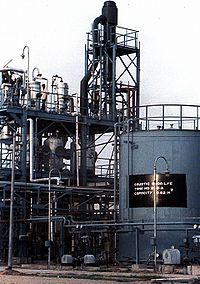
Photo from wikipedia
Abstract Falling film evaporation and pool boiling of R134a outside a typical reentrant enhanced tube was investigated with an experimental approach. Experimental data from literature with other refrigerants were also… Click to show full abstract
Abstract Falling film evaporation and pool boiling of R134a outside a typical reentrant enhanced tube was investigated with an experimental approach. Experimental data from literature with other refrigerants were also compared. The saturation temperature was 11 °C. It was found that the overall heat transfer coefficient for the enhanced tube was as much as 3 times higher than smooth tube. Shell-side falling film evaporation heat transfer coefficient increased by a factor of 2.1–4.9. Pool boiling yielded a higher heat transfer coefficient at higher heat flux for the same enhanced tube. The dependence of falling film evaporation heat transfer coefficient on the heat flux was also different from pool boiling for the same tube. Although the bubbles in pool boiling were pushed up by buoyancy and in falling film evaporating were driven by the flow of films, the transmission of energy were both dominated by the phase change heat transfer. The contribution of forced convection to falling film evaporation heat transfer coefficient is weak compared with phase change heat transfer.
Journal Title: Applied Thermal Engineering
Year Published: 2019
Link to full text (if available)
Share on Social Media: Sign Up to like & get
recommendations!